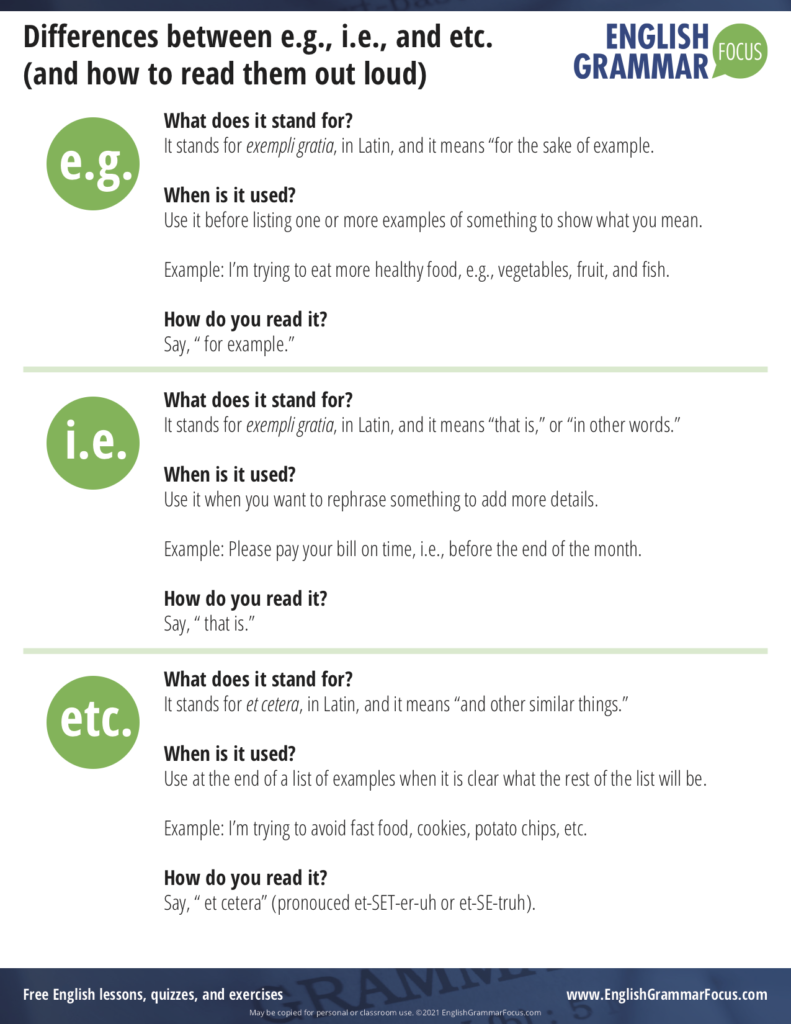Easiest way to remember the differences between i.e., e.g., and etc. (and how to read them out loud)
SHARE THIS:
Ready for the quiz?
Test your knowledge by taking the quiz. Try to get 10 out of 10 correct to become a grammar superstar!
Do you know the difference between i.e. and e.g.? What about etc.?
In this lesson I’ll tell you what these common abbreviations mean, how to easily remember the differences between them, and I’ll teach you the best way to read them out loud.
What are abbreviations?
Abbreviations are just shortened forms of words or phrases. We use them to save time, space, or both. You’re probably already familiar with a lot of them, such as:
Jan. = January
Mr. = Mister
ASAP = As Soon As Possible
In this lesson we are going to focus on these three common Latin abbreviations that are used in English because I’ve had a lot of students ask about them recently. So, if you’re ready to have your questions answered, let’s get started!
How to use e.g.
What does e.g. mean?
I’m trying to eat more healthy food (e.g., vegetables, fruit, and fish).
The abbreviation e.g stands for exempli gratia in Latin, and it means “for the sake of example.” This abbreviation is used before listing one or more examples of something to clarify what you mean. It is not a complete list, just more possibilities.
In this sentence, you can see a few examples of healthy food. There are definitely more possibilities that you can list, but these are enough to give the reader a better idea.
How to read e.g. out loud
We never read e.g. in its Latin form, exempli gratia. It is much easier and clearer to say “for example.” So, you would read this sentence as….
I’m trying to eat more healthy food (for example, vegetables, fruit, and fish).
How to use i.e.
What does i.e. mean?
The next abbreviation is i.e. It stands for id est, in Latin, and it means “that is.” This abbreviation is used to repeat something with different words to give the reader more details. This is similar to the phrase “in other words”.
Please pay your bill on time, i.e., before the end of the month.
In this example, the phrase “before the end of the month” makes it clear what “on time” means.
How to read i.e. out loud
Like e.g., we don’t read i.e. in its Latin form, id est. It is much easier and clearer to read it as “that is.” So, you would read the sentence like this: …
Please pay your bill on time, that is, before the end of the month.
How to use etc.
What does etc. mean?
The last abbreviation is etc. It stands for et cetera, in Latin, and it means “and other similar things.” This abbreviation is used at the end of a list of examples when it is clear what the rest of the list will be. It’s important that all of the things should be of the same kind. This is similar to the phrase “and so on.”
I’m trying to avoid fast food, cookies, potato chips, etc.
In this sentence, you can see three examples of junk food. You don’t need to see any more examples because you should be able to continue the list yourself.
Unlike the previous examples, we do read this abbreviation in its Latin form, et cetera. It can be pronounced et-SET-er-uh, or in the reduced version et-SE-truh.
Conclusion
I hope this lesson gave you a better idea of what these common abbreviations mean, and how to read them out loud. It is especially common for native speakers to forget the difference between e.g. and i.e.
There are several writing rules that I did not cover here. If you want to know more about the writing rules, let me know in the comments.
Are you ready for a challenge? Take the e.g., i.e., and etc. abbreviations quiz Share your results with your friends, and see who can get a higher score. If you get 10 out of 10, you’ll be a grammar superstar.
If you have any questions about anything that I covered about today? Let me know in the comments below.
Ready for the quiz?
Test your knowledge by taking the quiz. Try to get 10 out of 10 correct to become a grammar superstar!

